Ultimate Guide for Social Media Sentiment Analysis 2025
Social media sentiment analysis helps brands understand the emotions, perceptions, and reactions behind online conversations. This guide breaks down how sentiment analysis works, why it matters, the metrics involved, and how it strengthens brand strategy. Perfect for marketers, startups, agencies, and businesses looking to use emotional intelligence to drive smarter decisions in 2025.
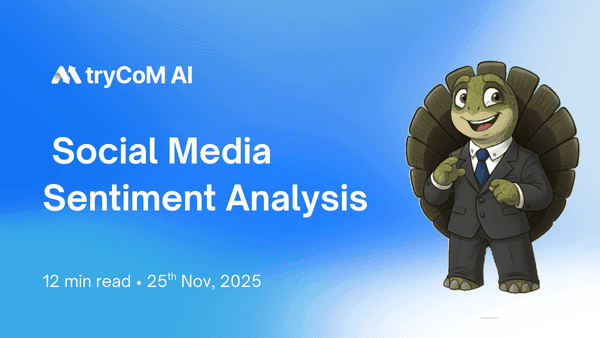
Quick Summary
- Sentiment analysis helps brands understand how audiences feel — not just what they say — across social media platforms.
- It uses AI, NLP, and machine learning to classify mentions as positive, negative, or neutral, and detect emotions like joy, frustration, or anger.
- Businesses use sentiment insights to measure brand perception, prevent crises, improve content strategy , and enhance customer experience.
- Conducting sentiment analysis involves data collection, cleaning, AI-driven classification, manual validation , and turning insights into action.
- Key sentiment metrics include sentiment score, net sentiment, emotion distribution , and share of voice with sentiment.
- Social sentiment directly influences brand strategy by highlighting audience expectations, pain points, and emotional reactions to campaigns.
Introduction
Every comment, review, mention, or reaction on social media carries an underlying emotion. Some posts celebrate your brand. Some criticize. Some express frustration. Some express love. Some are sarcastic. But if you’re only looking at likes, shares, impressions, and reach — you're missing the why behind the interactions. That “why” is sentiment.
Sentiment analysis, also known as opinion mining, is a method of evaluating how people feel about your brand online. It tracks emotions, context, and intentions across social conversations — making it a powerful lens for understanding real brand perception. In the age of AI, brands that actively monitor sentiment gain a significant advantage: they can react faster, improve better, and build stronger relationships with their audience.
What Is Social Media Sentiment Analysis?
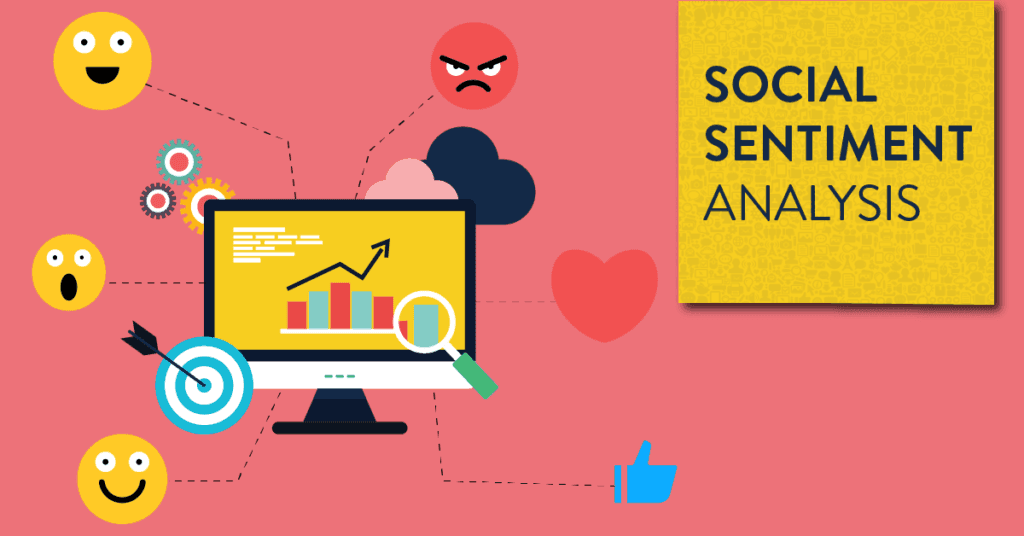
Social media sentiment analysis is the process of analyzing conversations, comments, mentions, and messages on social platforms to determine whether people feel positive, negative, or neutral about a brand, product, service, or topic.
Unlike basic social listening that only tracks volume or engagement, sentiment analysis looks deeper:
- Are people happy or upset?
- Is the feedback constructive or hostile?
- Is the audience excited about a launch?
- Are customers complaining about your service?
It uses machine learning, NLP (natural language processing), and contextual analysis to classify sentiment.
This helps brands move beyond counting conversations — into understanding conversations.
Why Sentiment Analysis Matters in Social Media Analytics
In the digital landscape, every conversation about your brand reveals a deeper emotional context that metrics like likes, impressions, and views cannot capture. Sentiment analysis fills this gap by identifying how people feel and why they feel that way.
1. Real-Time Awareness of Brand Perception
Social media is immediate. A single viral complaint can influence thousands within minutes. Sentiment analysis helps brands stay alert by tracking shifts in public mood as they happen. Whether your audience is celebrating a new product feature or showing frustration over an issue, real-time sentiment charts help you act before emotions spiral into crises.
2. Early Discovery of Risks & Crisis Indicators
Negative sentiment spikes often occur before traditional KPIs show warning signs. For example:
- A wave of angry comments about pricing
- A trending hashtag criticizing customer service
- Negative reviews appearing after a product launch
Sentiment monitoring detects these patterns early, giving brands a chance to respond proactively, clarify misinformation, or take corrective action.
3. Enhancing Customer Experience
Sentiment feedback highlights:
- Pain points in the user journey
- Features people love
- Frustrations customers consistently face
- Gaps in communication
By addressing the emotional triggers behind customer behavior, brands can redesign support workflows, product experiences, and response strategies to align with what customers truly value.
4. Optimizing Content & Messaging Strategy
Your audience’s emotional response to content is the strongest indicator of what resonates. Sentiment analysis identifies:
- Content themes that create excitement
- Posts causing confusion
- Campaigns that evoke loyalty
- Topics that trigger negativity
This allows marketers to refine creative direction—tone, visuals, messaging, and topics—based on emotional performance instead of guessing.
5. Competitor Perception Benchmarking
Sentiment analysis reveals what competitors’ audiences complain about, appreciate, or expect. By assessing how your sentiment compares, you can:
- Identify gaps competitors fail to solve
- Emulate what works well for them
- Position your brand more strategically
This competitive edge helps shape unique, emotion-driven brand positioning.
6. Identifying Advocates & Detractors
Sentiment segmentation uncovers:
- Loyal supporters who consistently praise your brand
- Detractors who influence negative reputation
Brands can convert neutral or negative users with targeted engagement strategies and build strong advocacy programs with positive supporters.
How Sentiment Analysis Works
Sentiment analysis combines linguistic modeling, AI algorithms, and contextual intelligence to extract emotional meaning from social conversations. Here's how it works behind the scenes:
1. Data Collection Across Platforms
Tools gather posts from:
- Instagram posts, reels, comments, DMs
- X/Twitter mentions, threads
- YouTube comments and transcripts
- Facebook posts, reviews, and messages
- LinkedIn posts, comments, and articles
- Reddit communities
- Blogs and news portals
The more diverse the dataset, the higher the accuracy.
2. Natural Language Processing (NLP) for Emotion Understanding
NLP breaks down raw text to understand:
- Keywords and key phrases
- Contextual meaning (e.g., "hot" as trending or angry)
- Polarity words (awesome, terrible, frustrating, love, hate)
- Emojis and symbols
- Sentiment-bearing patterns
This layer ensures the text is interpreted beyond surface-level words.
3. Machine Learning Models for Classification
AI models evaluate linguistic patterns, sentence structure, and historical data to classify:
- Positive sentiment
- Negative sentiment
- Neutral sentiment
- Emotional tones like anger, joy, fear, trust, surprise
Advanced algorithms use transformer models, deep learning, and conversation context to improve accuracy.
4. Human Review & Brand-Specific Calibration
Human oversight fine-tunes the model by:
- Correcting misclassifications
- Adding brand-specific keywords
- Handling slang and cultural nuances
- Tweaking sentiment rules for your industry
This hybrid approach delivers more reliable results.

Types of Sentiment Analysis
Different forms of sentiment analysis offer deeper emotional insights:
1. Polarity-Based Sentiment Analysis
Classifies conversations as:
- Positive
- Negative
- Neutral
This high-level insight helps brands see overall sentiment health.
2. Emotion-Based Sentiment Analysis
Goes beyond positivity/negativity by identifying emotions like:
- Joy
- Anger
- Trust
- Fear
- Surprise
- Sadness
- Disgust
This helps tailor content and responses empathetically.
3. Aspect-Based Sentiment Analysis
Breaks down sentiment by product features or service components.
Example:
“Camera is great but battery is horrible.”
- Camera → Positive
- Battery → Negative
Perfect for product teams and UX improvements.
4. Intent-Based Sentiment Analysis
Determines what the customer intends:
- Asking for help
- Filing a complaint
- Making a purchase
- Comparing brands
Supports customer support and sales alignment.
5. Sarcasm & Contextual Sentiment Analysis
Detects sarcastic tones like:
“Best update ever. My app won’t even open now.”
Sarcasm is the most complex to analyze and often needs human intervention.
Key Metrics & KPIs in Sentiment Analysis
Understanding sentiment metrics helps brands quantify emotional perception and make informed decisions. These KPIs provide both high-level and deep behavioral insights.
1. Overall Sentiment Score
- Measures the overall emotional tone of conversations around your brand.
- Usually displayed as positive, negative, or neutral — or on numeric scales like –1 to +1 or 0 to 100.
- Helps quickly understand whether audience sentiment is trending upward or downward.
2. Positivity and Negativity Rates
- Shows the percentage of positive vs. negative mentions in a given period.
- Helps identify if your campaigns or interactions shifted mood positively.
- Useful for comparing day-to-day or week-to-week emotional changes.
3. Net Sentiment Score
- Formula: (Positive Mentions – Negative Mentions) ÷ Total Mentions × 100
- Gives a more balanced and accurate view of sentiment by accounting for both good and bad conversations.
- Great for long-term monitoring of brand reputation.
4. Emotion Distribution
- Breaks conversations into emotional categories like joy, anger, surprise, trust, or fear.
- Provides deeper understanding beyond basic polarity.
- Helps marketers adjust tone, visuals, and messaging based on emotional patterns.
5. Topic or Feature-Level Sentiment
- Measures sentiment for specific aspects (ex: customer support, pricing, product quality).
- Helps identify which areas customers love and which areas need improvement.
- Useful for product teams, UX designers, and customer service leaders.
6. Share of Voice with Sentiment
- Compares your conversation volume and sentiment with competitors.
- Shows whether negative news about you is louder than their positive news (or vice-versa).
- Helps understand your position in the competitive landscape.
7. Negative Spike Alerts
- Automated alerts when negative mentions surge suddenly.
- Helps brands detect and respond to potential crises before they escalate.
- Can reveal product defects, trending complaints, or social backlash.
8. Influencer Sentiment Score
- Tracks sentiment specifically from high-reach or high-engagement accounts.
- Highlights whether influencers are advocating or criticizing your brand.
- Influential negative sentiment requires faster intervention.
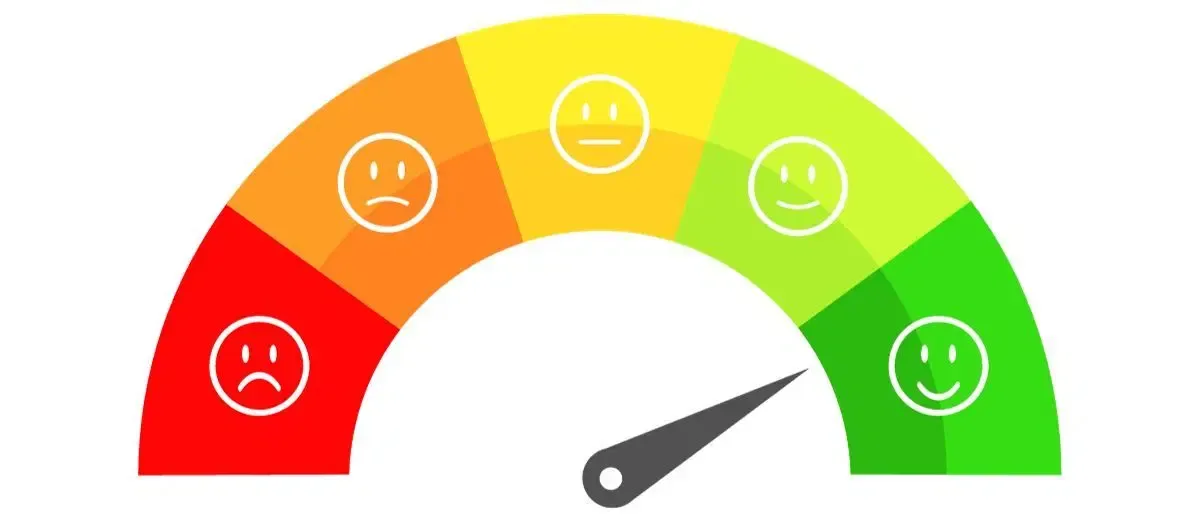
How to Conduct a Social Sentiment Analysis
A structured sentiment analysis process ensures both accuracy and actionable insights.
1. Define Your Objective
- Clarify what you want to measure: brand health, product feedback, competitor perception, or campaign reactions.
- Setting the right goal ensures you collect the right data and interpret results correctly.
2. Identify Relevant Platforms
- Choose platforms your audience actively uses — for some brands, Instagram matters more, for others, Reddit or X.
- Avoid spreading efforts across irrelevant platforms to keep data focused.
3. Collect All Relevant Conversations
- Gather mentions, hashtags, tags, direct messages, comments, UGC, and reviews.
- Use tools to automate collection and avoid manual errors.
- The richer the dataset, the more accurate your sentiment extraction.
4. Clean & Preprocess Your Data
- Remove bots, spam, repetitive posts, fake profiles, and irrelevant mentions.
- Normalize text (handling capitalization, punctuation, emojis, and typos).
- This step boosts the precision of NLP and AI classification.
5. Analyze Sentiment Using AI or Tools
- AI models classify text into positive, negative, and neutral categories.
- Some tools also detect emotions and identify the intention behind comments.
- Look for patterns over time rather than isolated fluctuations.
6. Validate with Manual Review
- Check a sample of conversations manually to correct any misclassifications.
- Critical for sarcasm, cultural expression, slang, and mixed emotional statements.
- This step enhances accuracy and makes the insights brand-specific.
7. Visualize Findings Through Dashboards
- Use graphs, sentiment timelines, word clouds, and topic clusters for easy interpretation.
- Visuals help teams — marketing, product, PR — understand sentiment instantly.
- Dashboards also make it easier to report insights to leadership.
8. Turn Insights Into Action
- Address common complaints, refine campaign tone, fix UX or product issues.
- Engage critics with empathy and reward advocates.
- Update strategy based on emotional triggers revealed in the analysis.
| Metric / Scoring Type | What It Measures | Why It Matters | How Brands Use It |
|---|---|---|---|
| Polarity Score (Positive / Negative / Neutral) | Classifies overall emotional tone of conversations. | Gives a quick snapshot of brand mood and public reaction. | Monitor daily mood shifts and general audience sentiment. |
| Weighted Sentiment Score | Adjusts sentiment impact based on influence, reach, and engagement. | Prevents low-impact posts from being weighted the same as high-impact posts. | Prioritize responses to influential users or viral posts. |
| Emotion Intensity Score | Detects strength of emotions like anger, joy, disappointment, surprise, etc. | Helps identify urgency and severity of audience reactions. | Escalate high-intensity negative emotions to PR or support teams. |
| Topic-Based Sentiment Score | Measures sentiment across key topics (pricing, delivery, customer support, product quality). | Provides detailed insights into what aspects are working or failing. | Improve products, refine support scripts, fix bottlenecks, adjust messaging. |
| Competitive Sentiment Score | Compares your sentiment with competitors in your industry. | Shows whether your brand is performing better or worse emotionally. | Benchmark performance and identify opportunities to differentiate. |
| Time-Based Sentiment Trend | Tracks how sentiment shifts over days, weeks, or months. | Reveals the impact of campaigns, announcements, or incidents over time. | Evaluate campaign success and measure long-term brand health. |
How Social Media Sentiment Analysis Can Improve Brand Strategy
Sentiment analysis does more than measure how people feel — it directly shapes smarter decision-making across marketing, customer experience, and product development. When brands understand emotions behind conversations, they can build strategies rooted in audience expectations, not assumptions.
- Strengthen and Personalize Your Content Strategy
- Improve Customer Support and Response Systems
- Enhance Product and Service Development
- Prevent Crises and Manage PR More Effectively
- Benchmark Against Competitors
Sentiment analysis turns emotions into actionable insights — helping brands humanize their strategy, refine their offering, and build trust that lasts.

The Challenges of Social Media Sentiment Analysis
Despite its powerful advantages, sentiment analysis still comes with complexities that marketers must understand. These challenges highlight why human oversight and contextual awareness remain essential.
- Sarcasm, Irony, and Humor Are Difficult to Detect: AI cannot always understand sarcastic tone, especially when the text seems positive but is actually negative.
- Slang, Regional Phrases, and Cultural Nuances: Social media language evolves rapidly — new slang, abbreviations, and cultural expressions appear constantly.
- Mixed Sentiments Within a Single Statement: Many posts express both positive and negative emotions at the same time.
- Emojis, GIFs, and Memes Add Extra Complexity: Emojis often express emotion more clearly than text.
Sentiment analysis is incredibly powerful, but not flawless. Recognizing these limitations helps brands apply it with the right expectations — and combine automation with human understanding for the most reliable results.
Conclusion
In a world where brand success depends not just on visibility but on trust, sentiment analysis is no longer optional — it’s essential. It helps brands understand how audiences feel, what they want, and how they react to every campaign, product update, and customer service interaction. When done consistently, sentiment analysis becomes the backbone of brand strategy — improving content, product decisions, customer experience, and overall reputation. Brands that embrace emotional intelligence through sentiment analysis will always stay one step ahead, building stronger connections and winning long-term loyalty.
Frequently Asked Questions (FAQs)
1. What is social media sentiment analysis?
Social media sentiment analysis is the process of using AI and NLP to understand whether conversations about your brand online are positive, negative, or neutral. It gives insight into audience emotions, opinions, and expectations.
2. Why is sentiment analysis important for brands?
It helps brands monitor real-time reputation, detect crises early, understand customer feedback, and refine marketing and product strategies based on emotional responses.
3. Which tools are best for sentiment analysis?
Popular options include Sprout Social, Brand24, Khoros, Buffer, and Thematic. Tools like Trycom offer AI-powered sentiment insights tailored for small businesses, creators, and agencies.
4. Can sentiment analysis detect sarcasm?
AI tools struggle with sarcasm and humor because intent isn’t always clear. This is why human validation and brand-specific tuning greatly improve accuracy.
5. What metrics should I track in sentiment analysis?
Track sentiment score, positivity rate, net sentiment, emotion distribution, topic sentiment, and competitor sentiment. These metrics reflect overall brand health and audience perception.
6. How often should brands analyze sentiment?
Ideally, sentiment should be monitored continuously — especially during product launches, campaigns, or crises. Weekly or monthly deep-dive reports help track long-term trends.

Annamalai Kathir (AK)
Annamalai Kathir (https://www.linkedin.com/in/annamalai-kathirkamanathan/) - Marketing Analytics & AI MarTech Expert. As tryCoM's CEO, he has dedicated his career to building AI tools that simplify marketing and performance optimization for startups, enterprise, and agencies. With 10+ years of expertise in SaaS product marketing, digital marketing, social media analytics, SEO/GEO optimization, and competitive intelligence, Annamalai leads the team in developing AI-powered marketing software that delivers social media listening, content automation, competitor analysis, and unified ROI measurement to help businesses and agencies achieve data-driven growth and measurable outcomes. Connect: https://akathir.github.io/ | https://www.instagram.com/akathirk/ | https://x.com/kathirannamalai
View profile →More blogs by Annamalai Kathir (AK)

Hashtag Analytics: The Complete Guide for 2025
Hashtag analytics is essential for understanding which hashtags truly boost your reach, engagement, and visibility across social media platforms. This guide breaks down the algorithms, metrics, and optimization techniques you need in 2025. Learn how to analyze performance and build a powerful, data-driven hashtag strategy.
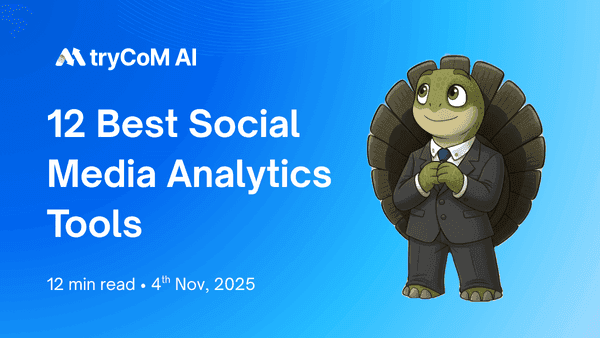
12 Best Social Media Analytics Tools Every Marketer Needs in 2025
Discover the 12 best social media analytics tools for 2025 that help marketers track performance, measure ROI, and gain deep audience insights. Learn how tryCoM unifies Google and social analytics for smarter, data-driven decisions.
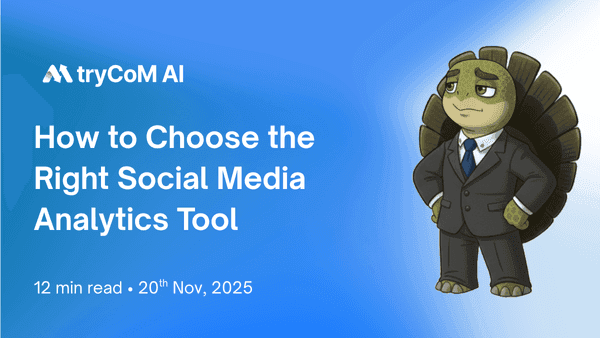
How to Choose the Right Social Media Analytics Tool for Your Business in 2025
Choosing the right social media analytics tool can significantly impact how businesses measure performance, understand their audience, and optimize content strategy. This blog explains what social analytics tools are, the features that matter, how to evaluate them, and why tryCoM stands out as a complete all-in-one solution for social, SEO, website, and ads analytics. Whether you're a brand, marketer, or agency, this guide will help you make a confident, data-driven decision.